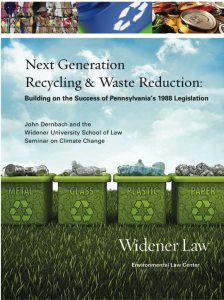PA Recycling Report
NEXT GENERATION RECYCLING AND WASTE REDUCTION:
BUILDING ON THE SUCCESS OF PENNSYLVANIA’S 1988 LEGISLATION
White Paper I – April 12, 2011 (.pdf)
John Dernbach and the
Widener University Law School Seminar on Climate Change
Environmental Law Center
Widener University
White Paper No. 1
April 2011
EXECUTIVE SUMMARY:
The Municipal Waste Planning, Recycling, and Waste Reduction Act (Act 101 of 1988) keeps millions of tons of materials out of landfills every year. It supports a multi-billion dollar industry that provides tens of thousands of jobs. It also probably affects human environmental behaviormore than any other statute in state history. And it reduces greenhouse gas emissions at the same time because of the materials and energy that are saved.
Yet the program is now rudderless and drifting. While the Act contains specific goals, those goals have either been met or ignored, and nonew goals have been set. It is impossible to say with a reasonable level of confidence whether recycling of Act 101 materials has increased or decreased over the past decade, let alone by how much. Per capita waste disposal is about the same now as it was when the Act was passed, and was much higher before the current economic downturn.
This White Paper is a collaboration with law students who learned to “reduce, reuse, recycle” in elementary school. They are part of the first generation who grew up under Act 101.
This Paper recommends that Pennsylvania set new and more ambitious recycling and waste reduction goals, use accurate and accessible data to measure progress, and once again give priority to public education on recycling and waste reduction. This Paper also contains many specific recommendations for reducing the amount of waste that is disposed of, and for increasing the amount of material that is recycled. These include expansion of the municipalities required to recycle as well as the materials to be included in recycling, greater emphasis on commercial and institutional recycling, requiring the use of “pay-as-you-throw” systems,
use of the grant program to support innovations in recycling and waste reduction, and creation of an honor roll to recognize companies for their contributions to recycling and waste reduction. Finally, it recommends stable and permanent financial support for the program.
These recommendations would lead to a more dynamic and effective program—a program more capable of turning waste into economic opportunity and job creation. These recommendations provide a platform for a serious conversation about the future direction of this program. To ensure that the opportunities of this program are fully available to the next generation of Pennsylvanians, including children who are now in elementary school, that conversation needs to begin now.
Comments Off on PA Recycling Report

